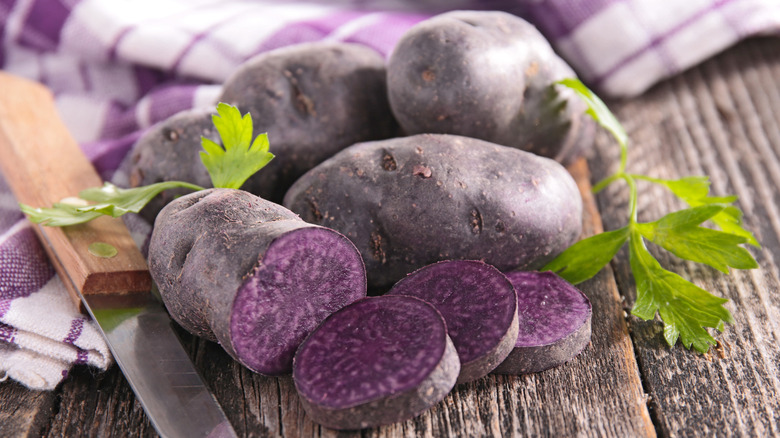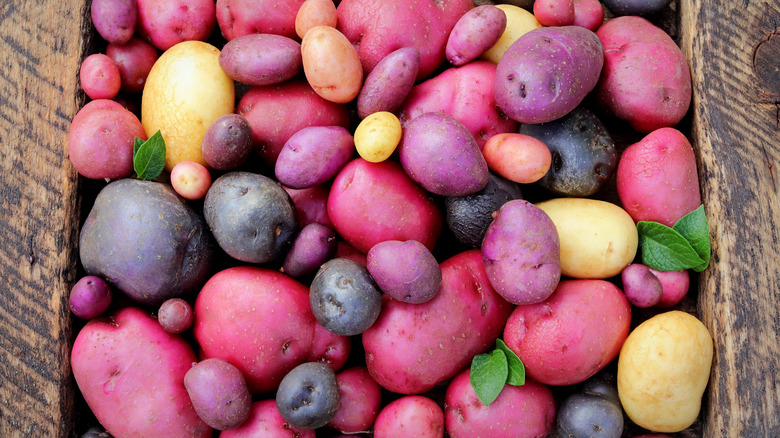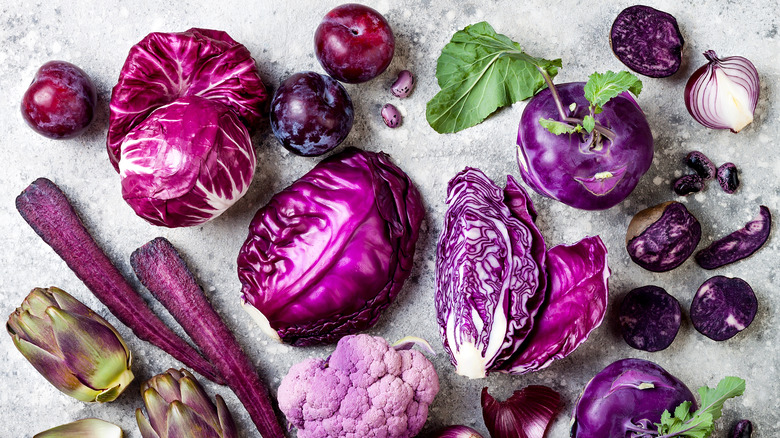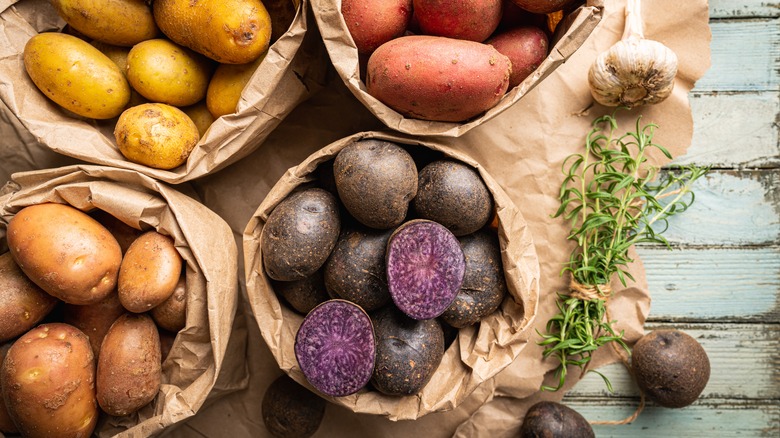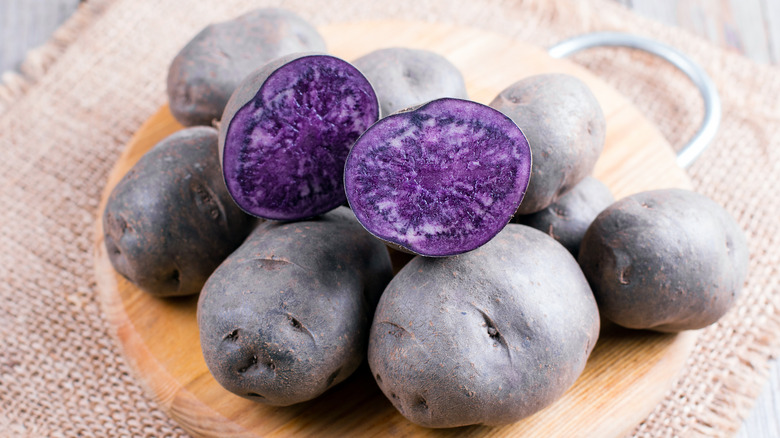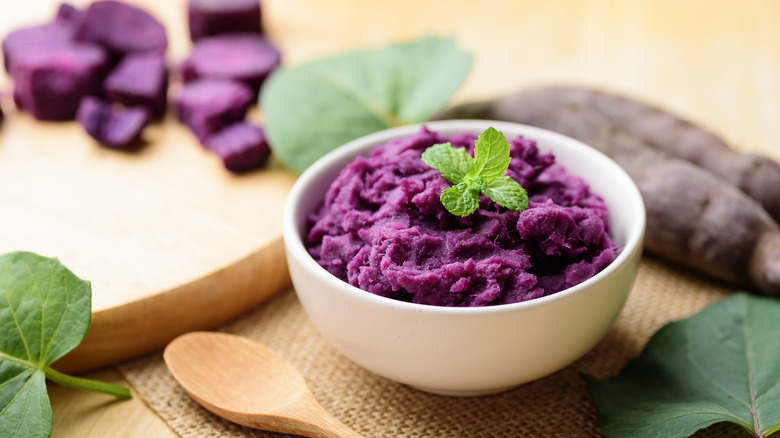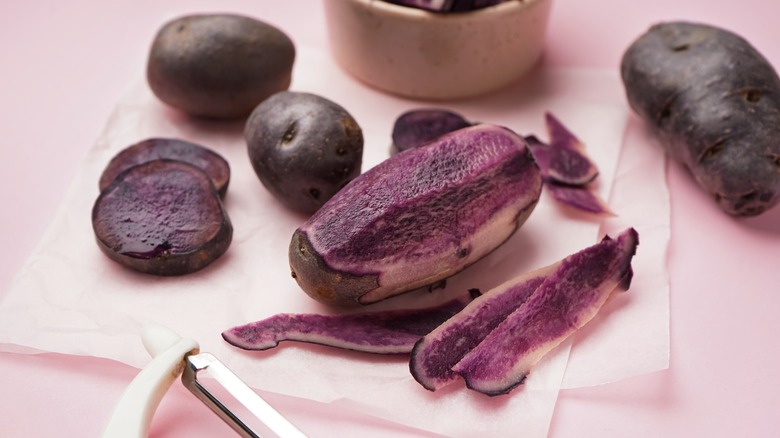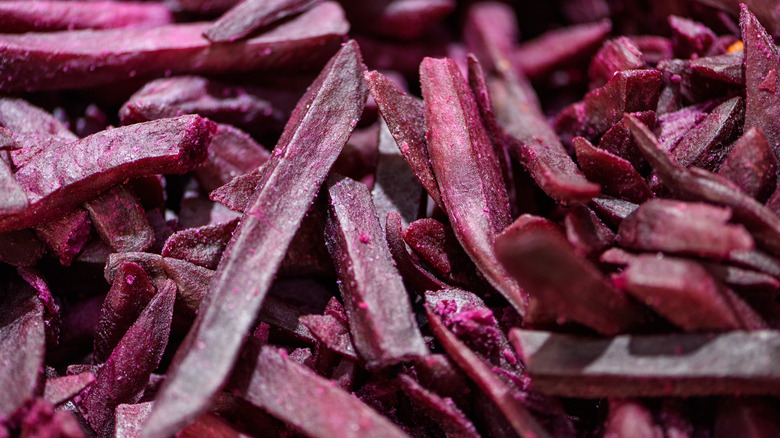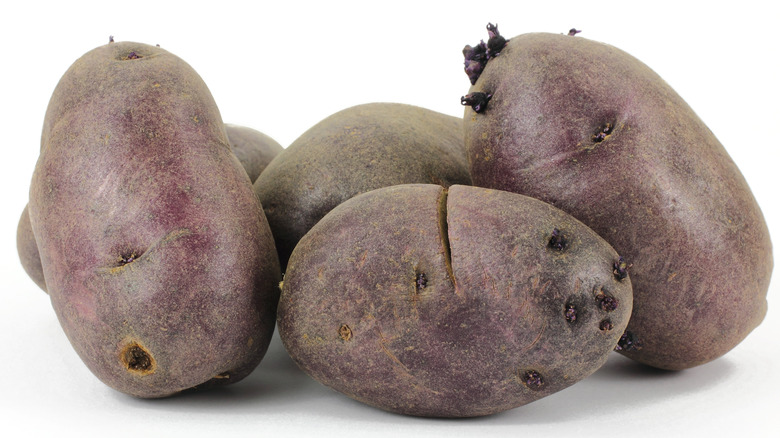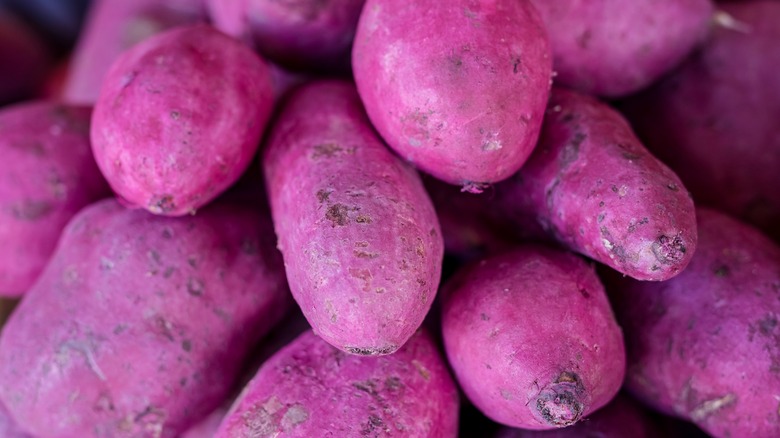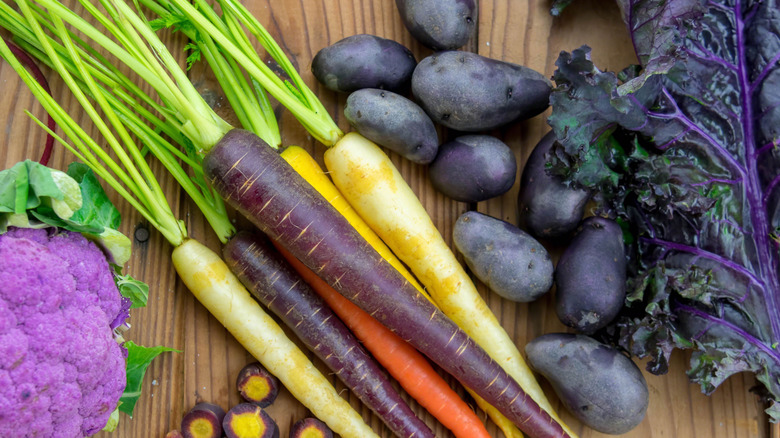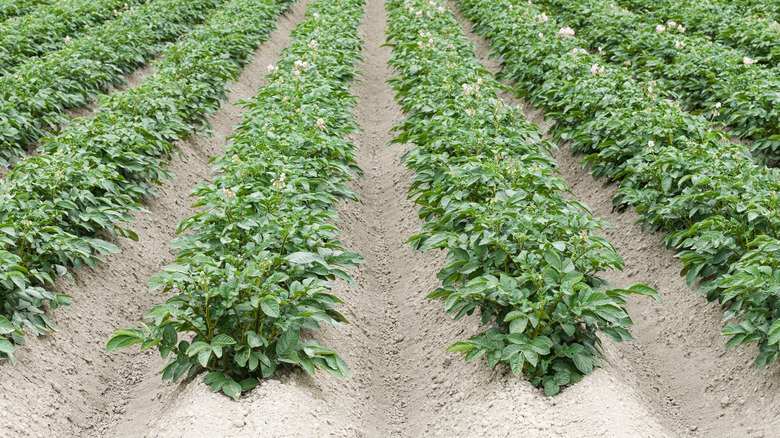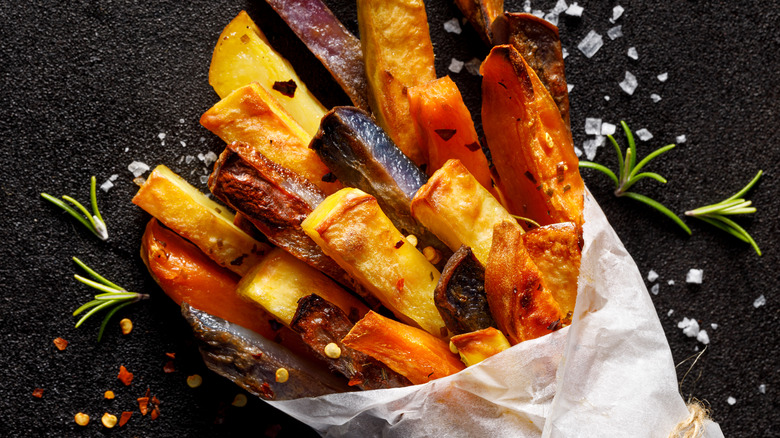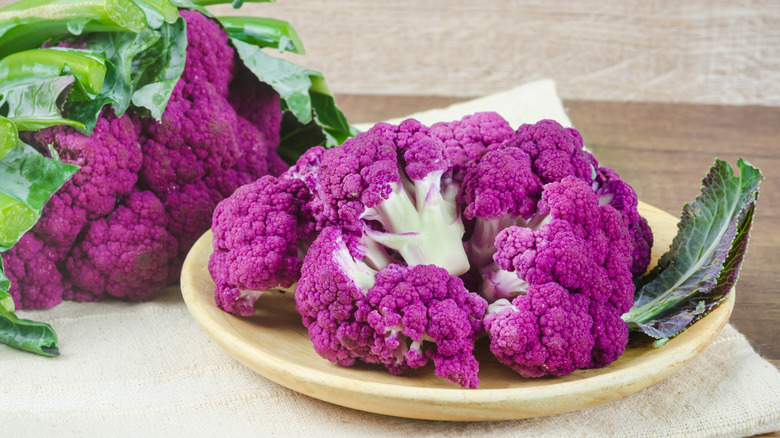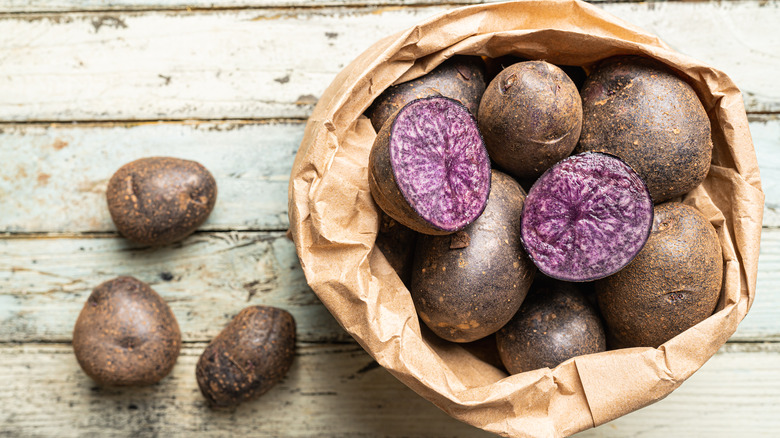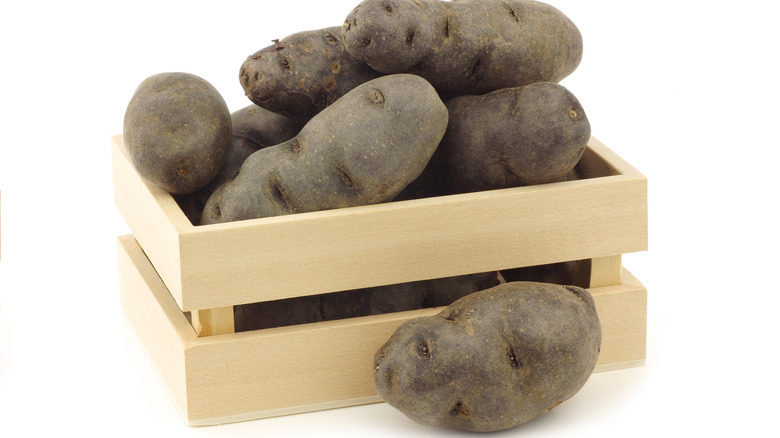What Are Purple Potatoes And What Do They Taste Like?
Perhaps one of the most aesthetically pleasing types of produce there ever was, the purple potato (Solanum tuberosum) is a versatile vegetable thanks to its healthful benefits, easy cooking, and even baking possibilities. You may have seen it used for a variety of dishes that typically call for regular potatoes, though a simple oven roast with salt and butter is enough to highlight the earthy taste this wondrous violet gem has to offer.
Known as tuber plants, they are grown mainly underneath the soil rather than on top, just like other potato varieties, according to Gardening Know How. The tuber is essentially the portion of the potato's root that can be safely eaten. Boasting loads of nutrients, purple potatoes are a great alternative to other types of potatoes, and they have some perks that you might be overlooking. Here's everything you need to know about purple potatoes, so you can cook them like a pro and enjoy every colorful bite.
What are purple potatoes?
With potatoes in the name, you've probably guessed that a purple potato is simply one of many potato varieties. A root vegetable, purple potatoes are in the nightshade family along with eggplants, tomatoes, and peppers.
Purple potatoes, occasionally referred to as blue potatoes, have a whole set of varieties and characteristics of their own. Originating from a tuber plant native to South America, purple potatoes weren't introduced to the United States until the 1980s. Currently, most purple potato imports come from Europe, South America, and North America. Ranging in size, they may appear as baby potatoes (typically only about 1.5 inches in diameter) or as big as a russet potato. One of the most common varieties of purple potato is known as "All Blue," and if you're shopping at a grocery store, these are the ones you're most likely to come across. In terms of the starch level, purple potatoes fall in the middle of the spectrum, making them better for some forms of cooking, such as roasting, baking, or frying, than others.
Why are they purple?
Rest assured, purple potatoes don't get their color from any kind of chemical engineering or genetic modifications. This root vegetable is all natural, and that's the best part. Plus, the reason they have such gorgeous violet tones is also to the consumer's benefit. Deem it nature's dye and you would not be too far off.
Purple potatoes contain anthocyanins, a flavonoid pigment that gives some fruits and vegetables their colors, ranging from reddish and blue to purple hues. It's also a type of healthy antioxidant. Purple produce — including purple cabbage, cauliflower, plums, and onions — is great for your health and hold an advantage over your standard russet variety. It's similar to sweet potatoes — their orange coloring is caused by carotenoids, another flavonoid pigment giving fruits and vegetables an orange coloring.
It's worth noting that when cooked, the deep color of purple potatoes' flesh may fade a little bit. Depending on the variety of potato, this could range from changing to simply a lighter purple or appearing more white all over. However, if using a microwave to heat them up, the purple tones will be preserved a little more.
Purple potatoes versus regular potatoes
Yes, purple potatoes will catch your eye at the supermarket for their vibrant color. While it's an obvious difference setting them apart from lighter varieties of potatoes, this isn't the only difference that makes purple potatoes so special compared to their more common counterparts.
Though the flavor of a purple potato can be compared to that of a russet, purple potatoes simply provide more health benefits. Though all potatoes contain antioxidants, purple potatoes are way ahead of the curb, as seen in their color. And according to Healthline, a key difference between your white and yellow potatoes and purple varieties is that the latter contains up to three times more antioxidants. Furthermore, the naturally occurring antioxidants in purple potatoes make the potassium also found in them easier for our bodies to synthesize. Though all potatoes contain high levels of potassium, it's especially great when that nutrient isn't lost thanks to antioxidants giving it an extra boost.
What part of the purple potato is edible?
When it comes to eating purple potatoes, you don't have to worry about peeling them unless you want to. You can eat every part of a purple potato, and you should. The flesh and skin of this vegetable both provide essential nutrients.
To eat or to not eat the skin of a purple potato fully depends on what your taste buds prefer. Of course, it is easier to skip peeling the skin off of purple potatoes. Really all they need is a gentle scrub and rinse under running water to remove dirt. They should always be cooked before enjoying and never eaten raw, but you can certainly boil them ahead of time and chill them for later if using them for a cold salad or your weekly meal prep. Depending on what recipe you're using them for, purple potatoes might benefit from having the skin removed (think mashed potatoes), but they'll certainly be tasty with the skin on if oven roasted, for instance.
What do purple potatoes taste like?
If you were to compare the taste of regular potatoes and purple ones, you would probably notice that regular ones are quite neutral when unseasoned. Purple potatoes carry a bit more flavor on their own. Depending on the variety of the purple potato, some boast a moist, creamy flesh, while others are a bit more dry and rough on the inside, and this will also change when cooking them, of course.
Packed with subtly sweet and nutty flavor notes, purple potatoes often have a less starch-heavy taste. They tend to be earthier in flavor than other types of potatoes. A little firm naturally, purple potatoes have a slight snap to them and less buttery texture when cooked than more standard russets or Yukon gold potatoes. Overall, you will notice that purple potatoes are a dense vegetable with a heartiness to them that can feel a bit heavier.
Why do purple potato skins taste metallic?
If you've ever eaten a plain purple potato with the skin on, you may have noticed a coppery taste, which isn't exactly the ideal flavor when attempting to enjoy a purple potato dish. While consuming purple potato skin is perfectly safe, the glycoalkaloids that occur naturally in all potato tubers give the outer skin a metallic, off-putting flavor. The most common type of glycoalkaloid found in potatoes is solanine. And in fact, when a potato starts turning from its normal color to a greenish color, this can sometimes be an indication that large amounts of solanine are present in it. While solanine is present in most potatoes in very small amounts, excessive exposure to sunlight makes them produce more of it, and that's when it becomes harmful and should not be consumed.
You might be wondering how to know if a purple potato is turning green, as it's harder to tell when its skin is darker than, say, a russet potato. Simply peel off a little bit of the skin to check for any green color directly underneath.
Fresh purple potatoes versus dehydrated
Even though it's more common, purple potatoes don't need to be served fresh only. Purple potatoes can also be dehydrated and made into chips, or a fine powder that can be used for cooking and baking different dishes.
So, what constitutes dehydrated? In the case of potatoes, any that have had their moisture removed can be labeled as so. Not only do dehydrated potatoes boast a longer shelf life than fresh ones, they're actually less costly to ship because they weigh less. Whether they're shredded, ground into powder, or dried sliced, potatoes are washed and peeled when undergoing the dehydration process. In terms of taste, dehydrated purple potatoes taste a little dry, starchy, and sweet, with a slightly chewy crunch.
If you want to try them at home, purple potatoes can simply be placed in a food dehydrator so that they'll keep for a while. For fresh purple potatoes, their shelf life will depend on how they are stored.
Are purple potatoes safe to eat when they sprout?
It's happened to many a home cook – you recall buying potatoes just the other day (whenever that was) and now the sprouting process has begun and you're unsure whether or not it's worth the risk. Good news — more often than not, you'll usually be able to salvage a sprouted potato, and this is also true of purple potatoes.
If you're noticing mild sprouting, you'll want to make sure you remove the sprouts before cooking. However, an excess amount of growth could mean the potato has developed an unhealthy amount of glycoalkaloids, in which case you'll want to throw them away. And if you're noticing that your purple potato is also wrinkled and soft to the touch, that means a one-way ticket to the garbage can. If you prefer not to waste food, then throw it in your garden or compost bin if you have one. Potatoes are especially prone to sprouting when exposed to darkness and moisture combined, because these conditions are what allow it to grow in the first place.
Other varieties of purple potatoes
Within the world of purple potatoes alone exists more variety than you probably thought. There are about 100 different types in total. According to Plantura, some of the most notable types used in cooking include the Vitolette, the Blue Swede, St.Galler, Blue Anneliese, and the Blaue Elise to name a few. Other common varieties include All Blue, Adirondack Blue, and Magic Molly.
Similarly to white and yellow potatoes, purple ones also vary in texture. Some range on the waxy side, others are creamy, and some steer on the more crumbly dry side of the spectrum. And the color can vary among each type of purple potato. The type known as Vitolette, for example, is both purple and white on the inside, giving its flesh a marbled effect.
One thing to keep in mind, though. Purple yams are not considered a variety of purple potato. Purple yams fall more into the sweet potato family and have their own distinct color, flavor, and texture. However, it's unlikely you will have to worry about making the distinction as true purple yams are difficult to find in the U.S.
How healthy are purple potatoes?
The purple in purple potatoes don't just serve an aesthetic purpose. The color also helps explain why this veggie is so rich in nutrients. And it's not just in the skin where you'll find all the health benefits. Purple potatoes contain loads of nutrients in their flesh, making them one of the healthiest vegetables in the potato family. They contain more potassium than bananas as well as a high level of antioxidants, powerful plant compounds help reduce cell damage. Specifically, purple potatoes contain a significant amount of vitamin C and selenium, both important for fighting inflammation, infections, and more.
Purple potatoes are also a great way to reduce blood sugar levels compared with other potato varieties, especially when paired with a protein. Furthermore, the vitamin B in purple potatoes aids with brain health and boosting your mood. There's a lot of reasons to love these purple powerhouses. Though, like other starchy foods, moderation is always key.
When are purple potatoes in season?
You might be looking to grow purple potatoes, or maybe you want to see when the most in-season options will arrive at your local grocery store. In either case, there are optimal conditions that will make your purple potatoes thrive, as well as ideal times of the year to seek them out.
Though available year-round, purple potatoes reach their peak season during the fall. If growing them yourself, when you harvest your purple potatoes will depend on when in the year you decide on planting them. Though it also depends on the variety of the purple potato, the size of the tuber ideal to you will determine the date in which they should be plucked from the ground.
A mainly hands-off experience, growing purple potatoes is simpler than you might expect. Not only do you have options in which varieties to grow, but you can also grow these vegetables in a garden or a container at home. Both manners require a lot of sunlight and soil that drains well. Watering them when the soil starts to dry up is one way to hydrate them properly, or once weekly to be safe. How do you know when it's time to pull them out of the ground? You can count on two to three months of a wait, or when the leaves of the plant jutting from the ground begin to die off and turn yellow.
How to cook with purple potatoes
Wondering how you can put these beautiful vegetables to use? First, you should know that while some varieties of purple potato are grainy in texture, others are smoother. This is due to the varying starch levels they contain. Some recipes benefit from more starch, and some will get gummy. For example, America's Test Kitchen says to reconsider using purple potatoes for dishes like gnocchi or latkes. Your resulting dish will likely be overly chewy and dense.
Need ideas for using the purple potatoes? We've got you covered. Your everyday mashed potatoes recipe can be swapped out for these violet gems. Try seasoning and oven roasting them, stuffing or smashing and baking in the oven, or turning them into home fries. Hasselback or scalloped potatoes will also work great as well. Make a purple potato salad for lunch, or dice up a few and saute on the stovetop before serving with eggs for a healthy breakfast option. You can whip up purple potato soup. Or get creative with a sweet purple potato pie.
Substitutes for purple potatoes
Maybe you did not find purple potatoes at the grocery store today, or maybe you'd like an alternative to the vegetable. You're in luck, because there are a few options out there for you. In the case that you are looking to cut down on carbohydrates and starches in your next meal, purple cauliflower is a great alternative to purple potatoes when preparing them mashed.
Jicama, a type of root vegetable with a white flesh and notes of apple and potatoes is also a good alternative. It's low in carbohydrates and you'll still get that earthy flavor unique to the purple potato. Both options can be heated and cooked, and you can even use jicama to make fries. Purple daikon is another healthy option that is closer in color, too. Though a radish, these can also be roasted, steamed, fried, and more. But know you'll have the option to eat these raw if you'd like. Slightly peppery with notes of sweetness, this is a strong alternative to the purple potato.
Where to buy purple potatoes
An effective way to make sure you're not wasting your money on purple potatoes is to make sure they're fresh when bought. When at the grocery store, checking for an overall firm but smooth texture free from bruises and no developing sprouts is key. Often available by the pound, purple potatoes can be found at most grocery stores in the produce aisle. Some are available in bags, and smaller variations of the vegetable can be found in bags of mixed potato medleys.
In a grocery store, you might not know the exact variety of purple potato you're getting, and it might be unclear whether the flesh will be purple when cut open. For this reason, farmers markets are an ideal place to pick up some purple potatoes. It's also where you'll get the freshest ones, as it's likely they've been pulled from the ground within a day of appearing at the market.
How to store purple potatoes
When it comes to whole, uncooked purple potatoes, you've got a couple options for storing them properly. Not only does storing them the right way help their shelf life, you'll also be making sure their nutrients are retained. As a rule of thumb, remember that potatoes in general need room to breathe when stored, and purple potatoes are no exception.
How can you make sure you get the most life out of your purple gems? Assuming they're still in their raw state, never store them in an airtight container. This is why you'll see potatoes stored at grocery stores in mesh or paper bags. The trapped moisture will encourage mold to take over or cause them to ripen and spoil faster. A bowl with no lid on it or an open basket are great storing options, so long as you're giving your purple potatoes space for air.
A dry, cool place is another way to ensure you're not prematurely ending your purple potatoes' culinary potential. A dry environment is key to avoid moisture buildup, and they'll survive up to 14 days at room temperature. Never place them in the fridge, as cold temperatures can make their starches turn to sugar, making them mold faster and brown when they cook.
